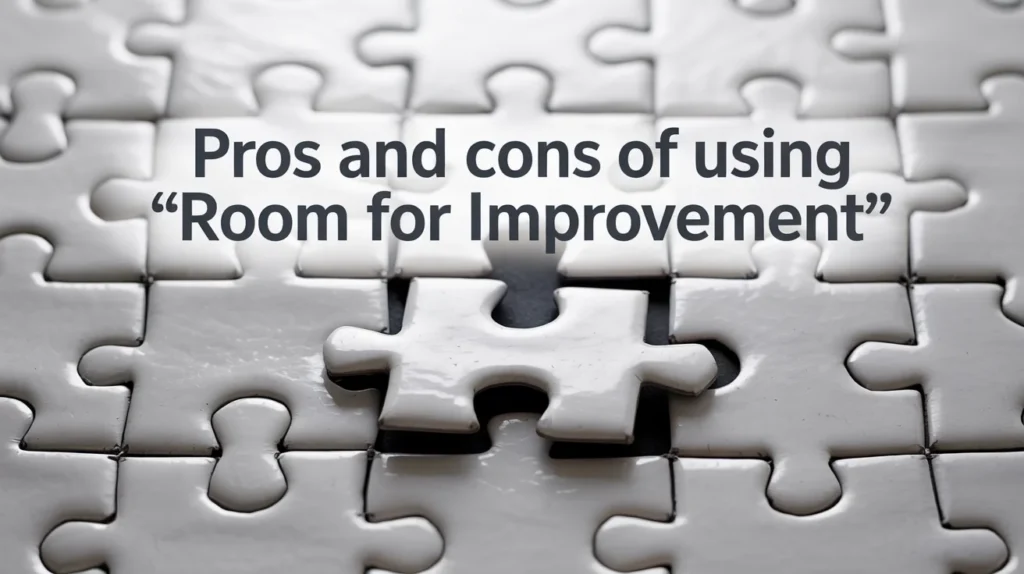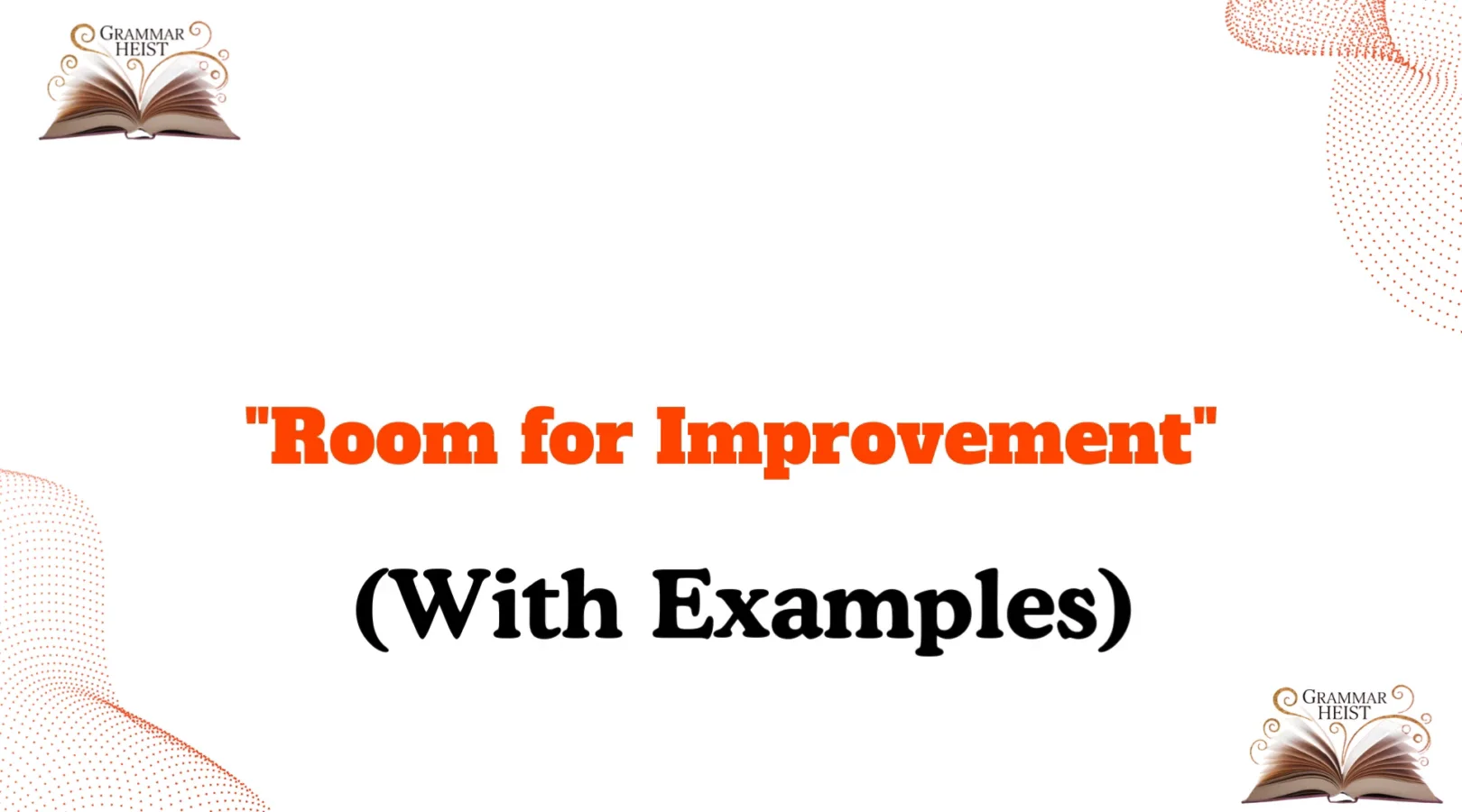Finding the right words to offer feedback can make all the difference. Whether you’re talking to a colleague, student, friend, or loved one, choosing a thoughtful phrase ensures that your message is constructive and encouraging rather than discouraging. Using warm and empathetic language fosters a sense of growth rather than inadequacy.
In this article, we’ll explore 30 alternatives to “room for improvement” that will help you communicate with care, professionalism, and encouragement.
Is It Professional/Polite to Say “Room for Improvement”?
Yes, “room for improvement” is generally considered polite and professional, making it a safe phrase in most situations. However, in some contexts, it can sound a bit vague or indirect, leaving the recipient unsure about how to improve. Additionally, some people may feel disheartened by the phrase if not delivered with encouragement.
By using alternative expressions, you can customize your feedback to be more supportive, specific, or motivational, depending on the situation.
Pros and Cons of Using “Room for Improvement”

Pros:
- Polite and diplomatic – avoids sounding harsh
- Recognized in professional and academic settings
- Encourages a mindset of growth
Cons:
- Lacks specificity – doesn’t always provide clear guidance
- Can feel impersonal – may not resonate emotionally
- Might still imply shortcomings rather than potential
Synonyms For “Room for Improvement”
- Opportunities for Growth
- Potential for Progress
- Areas to Strengthen
- Ways to Enhance
- Chances to Improve
- Ways to Refine
- Scope for Development
- Space to Evolve
- Possibilities for Betterment
- Steps Toward Excellence
- Room to Grow
- Ways to Elevate
- Scope to Polish
- Places to Improve
- Ways to Sharpen Skills
- Path to Mastery
- Areas to Fine-Tune
- Potential to Upgrade
- Opportunities to Hone
- Path for Refinement
- Ways to Strengthen
- Areas to Develop Further
- Chances to Evolve
- Opportunities for Expansion
- Growth Areas
- Key Focus Points
- Ways to Level Up
- Scope for Adjustment
- Opportunities for Optimization
- Refinement Opportunities
1. Opportunities for Growth
Scenario: Giving feedback to an employee after a performance review.
Examples:
- “You’ve made excellent progress, and I see great opportunities for growth in leadership.”
- “Your skills are strong, and there are a few opportunities for growth in client communication.”
- “Let’s focus on the opportunities for growth in your project management approach.”
Tone: Encouraging, supportive, and professional.
Explanation: This phrase highlights positive potential rather than deficiencies, making it motivating and constructive.
2. Potential for Progress
Scenario: Coaching a student on their coursework.
Examples:
- “Your writing has a lot of potential for progress, especially in structuring your arguments.”
- “With a little more practice, I see so much potential for progress in your math skills.”
- “Your understanding is solid, and there’s clear potential for progress in your presentation delivery.”
Tone: Optimistic, uplifting, and constructive.
Explanation: This phrase keeps feedback goal-oriented while instilling confidence in the recipient.
3. Areas to Strengthen
Scenario: Providing feedback to a sports team.
Examples:
- “Your teamwork is strong, and there are some areas to strengthen in communication on the field.”
- “We’ve identified areas to strengthen, like defensive strategies and coordination.”
- “Your endurance is great! Now, let’s focus on the areas to strengthen, such as agility and speed.”
Tone: Encouraging and action-oriented.
Explanation: This alternative acknowledges strengths while identifying specific focus areas for improvement.
4. Ways to Enhance
Scenario: Coaching a colleague on their presentation skills.
Examples:
- “Your storytelling is compelling! We can explore some ways to enhance audience engagement.”
- “Your slides are clear; let’s look at some ways to enhance the visual appeal.”
- “There are always ways to enhance confidence when speaking in front of a group!”
Tone: Positive and motivating.
Explanation: “Enhance” implies refining existing strengths rather than fixing weaknesses.
5. Chances to Improve
Scenario: Encouraging a student working on their writing skills.
Examples:
- “Your essay is well-structured, and I see chances to improve the transitions between paragraphs.”
- “Your storytelling is strong—there are chances to improve word choice for a more compelling effect.”
- “Grammar is solid, and we have chances to improve sentence variety to keep the reader engaged.”
Tone: Optimistic and reassuring.
Explanation: “Chances to improve” makes improvement sound like an exciting opportunity rather than a shortcoming.
6. Ways to Refine
Scenario: Providing feedback to an artist or designer.
Examples:
- “Your design concept is excellent, and there are ways to refine the color scheme.”
- “Your sketch is fantastic! Let’s look at some ways to refine the shading for more depth.”
- “This logo is powerful—we just have a few ways to refine the typography to make it stand out.”
Tone: Encouraging and detail-focused.
Explanation: “Refine” suggests polishing and improving existing skills rather than fixing mistakes.
7. Scope for Development
Scenario: Providing feedback to a junior employee on a project.
Examples:
- “Your analysis was insightful, and there’s scope for development in how you present your findings.”
- “Your report is thorough, with scope for development in structuring the key takeaways.”
- “You’re doing great work—there’s always scope for development in time management strategies.”
Tone: Professional and constructive.
Explanation: This phrase keeps feedback neutral and professional, making it great for workplace settings.
8. Space to Evolve
Scenario: Supporting someone on a personal growth journey.
Examples:
- “You’ve made so much progress, and there’s still space to evolve in your leadership approach.”
- “We all have space to evolve, and you’re already heading in the right direction!”
- “Your confidence is growing, and there’s space to evolve as you take on more challenges.”
Tone: Inspirational and forward-looking.
Explanation: “Evolve” feels natural and continuous, making it ideal for personal development discussions.
9. Possibilities for Betterment
Scenario: Discussing self-improvement goals with a friend.
Examples:
- “You’ve been working hard, and there are always possibilities for betterment in any skill.”
- “We all have possibilities for betterment—what’s one area you’d like to focus on next?”
- “Your progress is impressive, and I see exciting possibilities for betterment in your approach.”
Tone: Uplifting and encouraging.
Explanation: “Betterment” conveys a continuous journey toward self-improvement rather than a problem that needs fixing.
10. Steps Toward Excellence
Scenario: Coaching an athlete aiming for peak performance.
Examples:
- “You’re already performing well—these are just small steps toward excellence.”
- “Every great athlete takes steps toward excellence with every practice session.”
- “Your progress is commendable, and with a few adjustments, you’re taking key steps toward excellence.”
Tone: Motivational and high-achieving.
Explanation: This phrase emphasizes a path to greatness, making it highly encouraging for ambitious individuals.
11. Room to Grow
Scenario: Encouraging a new team member in their role.
Examples:
- “You’re already contributing well, and there’s room to grow in strategic thinking.”
- “Everyone has room to grow, and I’m excited to see where you take your skills next!”
- “Your confidence is increasing—you still have room to grow, but you’re on the right path!”
Tone: Supportive and reassuring.
Explanation: This phrase acknowledges progress while emphasizing potential.
12. Ways to Elevate
Scenario: Helping someone improve their public speaking skills.
Examples:
- “Your speech was engaging—let’s explore some ways to elevate your delivery.”
- “Your message is powerful—there are always ways to elevate clarity and impact.”
- “The content is solid! Now, let’s focus on ways to elevate audience engagement.”
Tone: Encouraging and empowering.
Explanation: “Elevate” conveys a step up rather than a need to fix something.
13. Scope to Polish
Scenario: Reviewing a draft of a marketing campaign.
Examples:
- “Your campaign idea is strong—there’s just some scope to polish the messaging.”
- “The visuals are great, with a little scope to polish the overall aesthetic.”
- “Your pitch is persuasive—there’s always scope to polish the delivery for greater impact.”
Tone: Refined and constructive.
Explanation: “Polish” suggests fine-tuning rather than overhauling.
14. Places to Improve
Scenario: Helping a student with test-taking strategies.
Examples:
- “Your understanding of the concepts is solid—there are just a few places to improve in application.”
- “You’re getting better! Let’s work on some places to improve in time management.”
- “Great effort! We’ve identified some key places to improve before the next test.”
Tone: Encouraging and clear.
Explanation: This phrase pinpoints specific areas while keeping the tone positive.
15. Ways to Sharpen Skills
Scenario: Mentoring a junior colleague in sales techniques.
Examples:
- “Your persuasion skills are great—let’s look at some ways to sharpen skills in objection handling.”
- “Your networking is impressive—there are always ways to sharpen skills in building lasting client relationships.”
- “Your confidence is growing! Let’s explore ways to sharpen skills in negotiating.”
Tone: Focused and skill-oriented.
Explanation: This alternative focuses on refining expertise rather than pointing out weaknesses.
16. Path to Mastery
Scenario: Encouraging a musician refining their technique.
Examples:
- “You’re making incredible progress—each practice session is a step on your path to mastery.”
- “Your technique is strong, and refining dynamics will take you further on your path to mastery.”
- “Every great musician embraces the path to mastery—you’re well on your way!”
Tone: Inspiring and goal-oriented.
Explanation: This phrase frames improvement as an exciting journey toward excellence.
17. Areas to Fine-Tune
Scenario: Providing feedback to a software developer on their coding style.
Examples:
- “Your code is clean, with just a few areas to fine-tune for efficiency.”
- “You’ve built a solid foundation—there are some areas to fine-tune in error handling.”
- “Your logic is great! Let’s look at some areas to fine-tune for better readability.”
Tone: Detail-oriented and encouraging.
Explanation: “Fine-tune” suggests small, manageable improvements rather than major overhauls.
18. Potential to Upgrade
Scenario: Coaching a business professional on their leadership skills.
Examples:
- “You’ve got strong leadership qualities, and I see the potential to upgrade decision-making strategies.”
- “Your confidence is growing, and there’s potential to upgrade your delegation skills.”
- “You’re already a great communicator—there’s potential to upgrade your conflict resolution approach.”
Tone: Motivating and forward-looking.
Explanation: “Upgrade” makes improvement sound like an exciting enhancement rather than a necessity.
19. Opportunities to Hone
Scenario: Helping an athlete refine their technique.
Examples:
- “Your speed is impressive, and there are opportunities to hone your endurance.”
- “You have a strong foundation—let’s focus on opportunities to hone your accuracy.”
- “Your footwork is solid, and we can explore opportunities to hone your reaction time.”
Tone: Encouraging and skill-focused.
Explanation: “Hone” suggests sharpening and refining skills rather than fixing weaknesses.
20. Path for Refinement
Scenario: Offering feedback on a research paper.
Examples:
- “Your argument is well-structured—there’s a clear path for refinement in supporting evidence.”
- “Great research! We have a path for refinement in the clarity of your thesis statement.”
- “Your ideas are insightful, and there’s a path for refinement in how they’re organized.”
Tone: Supportive and process-oriented.
Explanation: This phrase frames improvement as a clear, manageable process.
21. Ways to Strengthen
Scenario: Advising a team on their project strategy.
Examples:
- “Your teamwork is strong—there are ways to strengthen your problem-solving approach.”
- “The project plan is well thought out—let’s explore ways to strengthen risk management.”
- “Your proposal is compelling, and we can find ways to strengthen the data analysis section.”
Tone: Constructive and empowering.
Explanation: “Strengthen” conveys building upon existing skills rather than pointing out flaws.
22. Areas to Develop Further
Scenario: Encouraging a student in a leadership program.
Examples:
- “You have strong communication skills, with areas to develop further in active listening.”
- “Your leadership qualities are emerging—there are areas to develop further in conflict resolution.”
- “You’re a natural problem-solver, with some areas to develop further in decision-making speed.”
Tone: Encouraging and growth-oriented.
Explanation: This phrase emphasizes continuous development rather than deficiencies.
23. Chances to Evolve
Scenario: Supporting someone in their personal growth journey.
Examples:
- “You’ve come so far, and there are always chances to evolve as a leader.”
- “Growth is a lifelong journey—there are always chances to evolve and learn.”
- “You’re already thriving, and I see great chances to evolve in your mindset and resilience.”
Tone: Inspirational and positive.
Explanation: “Evolve” suggests natural growth and transformation.
24. Opportunities for Expansion
Scenario: Helping a business owner scale their company.
Examples:
- “Your brand is growing, and there are exciting opportunities for expansion in new markets.”
- “Your customer base is solid—let’s explore opportunities for expansion in online sales.”
- “Your service offerings are great—there may be opportunities for expansion into new demographics.”
Tone: Visionary and strategic.
Explanation: This phrase focuses on growth and scaling rather than fixing limitations.
25. Growth Areas
Scenario: Providing a teacher with professional development feedback.
Examples:
- “Your classroom management is strong, with some growth areas in lesson pacing.”
- “You’re a fantastic educator! Let’s look at growth areas in student engagement strategies.”
- “You’ve mastered content delivery—there are growth areas in differentiated instruction.”
Tone: Supportive and professional.
Explanation: “Growth areas” keeps the focus on progress rather than problems.
26. Key Focus Points
Scenario: Reviewing a marketing strategy.
Examples:
- “Your campaign is strong—here are a few key focus points to enhance engagement.”
- “We’ve identified some key focus points for improving brand consistency.”
- “Your strategy is solid—let’s go over the key focus points for optimizing conversions.”
Tone: Clear and action-driven.
Explanation: This phrase provides specific direction for improvement.
27. Ways to Level Up
Scenario: Encouraging a gamer to refine their skills.
Examples:
- “Your reaction time is great! Let’s explore ways to level up your strategy.”
- “You’ve got the basics down—now we can find ways to level up your competitive play.”
- “Your teamwork is solid! There are ways to level up coordination with your squad.”
Tone: Motivating and dynamic.
Explanation: “Level up” makes improvement feel exciting and game-like.
28. Scope for Adjustment
Scenario: Tweaking a social media marketing campaign.
Examples:
- “Your ad campaign is performing well, with some scope for adjustment in targeting.”
- “The engagement is high! There’s scope for adjustment in content frequency.”
- “Your visuals are stunning—let’s check if there’s scope for adjustment in messaging.”
Tone: Professional and analytical.
Explanation: “Adjustment” implies minor tweaks rather than major changes.
29. Opportunities for Optimization
Scenario: Helping a company improve its workflow efficiency.
Examples:
- “Your team is doing great work! There are opportunities for optimization in task delegation.”
- “Your system is efficient, but there may be opportunities for optimization in automating reports.”
- “Let’s look for opportunities for optimization in reducing processing time for customer orders.”
Tone: Strategic and efficiency-driven.
Explanation: “Optimization” makes improvement sound like a positive enhancement rather than a correction.
30. Refinement Opportunities
Scenario: Reviewing a final draft of a business proposal.
Examples:
- “Your proposal is well-structured, with just a few refinement opportunities in clarity.”
- “This is already strong—let’s explore some refinement opportunities for greater impact.”
- “You’re almost there! A few small refinement opportunities will make this even better.”
Tone: Encouraging and detail-focused.
Explanation: “Refinement” implies polishing something good to make it great.
Conclusion
When offering feedback, how you say something matters just as much as what you say. Choosing a phrase that’s constructive, motivating, and supportive can make a world of difference in how your message is received.
Instead of saying “room for improvement,” you now have 30 warm and thoughtful alternatives that encourage growth and positivity. Whether you’re giving feedback to a colleague, student, or friend, these phrases ensure that your words inspire progress rather than discourage.

Emma Brooke is a passionate advocate for effective communication and language mastery. As a dedicated professional in the field of grammar and writing, Emma brings a wealth of knowledge and expertise to those seeking to improve their linguistic skills. With a focus on clarity, precision, and style, Emma Brooke is committed to helping individuals refine their language use to communicate confidently and effectively.












